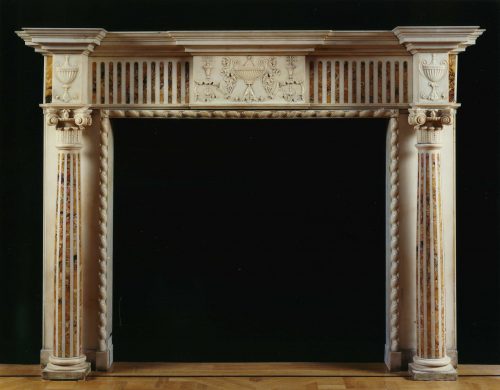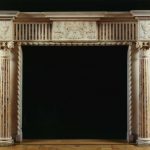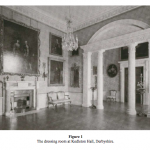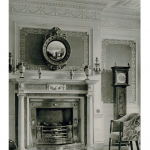7005 A FINE STATUARY AND CONVENT SIENA MARBLE NEOCLASSICAL CHIMNEYPIECE IN THE MANNER OF ROBERT ADAM English. Circa 1770. Measurements: Overall Height: 59 1/2″; Overall Width: 80 3/4″; Overall Depth: 14″. Height of Aperture: 44 1/4″; Width of Aperture: 49 1/2″.

-
Figure 1
-
Figure 2
Research
Of statuary and siena marble. The projecting molded shelf above a frieze with inlaid flutes of siena marble and centered by a panel carved in relief with an urn flanked by berried vines and scrolling foliate tendrils, the frieze flanked by two plinth blocks carved in relief with fluted urns, the aperture edged with a rope-twist molding and flanked by two tapering columns, each column surmounted by a foliate capital, the shaft inlaid with fluting of siena marble.
Provenance:
Bentley Angliss, who acquired it from a distinguished Madrid collection.
The present chimneypiece is much in the manner of the celebrated architect and designer Robert Adam (1728-92), the most influential leader of taste of his day. The form of the chimneypiece is familiar from many of Adam’s most famous interiors whilst the carved details draw heavily on Adam’s decorative vocabulary.
A chimneypiece of markedly similar form to the present example can be found in the dressing room at Kedleston Hall, Derbyshire, the house completed and decorated by Adam for Lord Scarsdale in 1760-70 (figure 1).1 In both chimneypieces the apertures are flanked by freestanding columns, which project forward of the backs, with inlaid flutes. The entablatures above the columns are decorated with stylized urns with finely worked moldings, whilst the frieze in both pieces is centered by a carved decorative panel. Above the frieze the piece is surmounted by a shelf reminiscent of that seen in the present example.
The general form seen at Kedleston was used repeatedly by Adam. The chimneypiece from the drawing room at Lansdowne House, Berkeley Square, designed by Adam for the 1st Marquess of Lansdowne in 1762, was another example of this type.2
The capitals of the present chimneypiece are notable for their curious composition. Repeating crimped stiff leaves form the necking of the capital below scrolling volutes centered by a stylized leaf motif. The confident ingenuity of the design is increased by the gadroon molding that frames the aperture, a Renaissance motif, reinterpreted in a neoclassical setting.
A strikingly similar arrangement to the capitals appears in a chimneypiece at Rushton Hall, Northamptonshire, standing in the “Adam bedchamber” and much in the manner of that architect (figure 2). In that example, the stiff leaves of the column’s necking are a shortened version of those of the present piece and appear below a frieze inlaid with siena marble fluting centered by a decorative panel and with stylized urn decoration above the columns as in the present piece.3
A certain freedom of design is a characteristic of the Adam style. Adam himself would depart from the strict precedent of the ancient sources that were the inspiration for his work. In the magnificent anteroom at Syon House, built for the 1st Duke of Northumberland between 1762-1769, Adam uses a giant Ionic order from the Erectheion on the acropolis, but detaches the palmette necking from below the volutes of the capital and reintroduces it as a repeating motif in the frieze.4 In Adam’s work the designs of antiquity would be varied and re-interpreted with a startling originality in a learned and sophisticated play of ideas and forms designed to impress and delight the cognoscenti of the time.
The decoration employed in the projecting panel to the centre of the frieze of the present chimneypiece and the form of the urns over the columns, is also in the manner of Adam’s interior style. The finely crafted gilded plasterwork of the Library at Kenwood, built by Adam for the 1st Earl of Mansfield in 1767-9, makes clear the similarity of the motifs employed and the manner of their composition.5 As in the present piece acanthine scrolls issue from a cluster of inverted leaves below an urn of stylized form, whilst the center of the scroll itself issues a decorative upright surmounted by the form of an urn terminating in a stylized palm frond.
Footnotes:
1 Eileen Harris, The Genius of Robert Adam: His Interiors, New Haven and London: Yale University Press (2001), p. 30.
2 ibid., p. 120, figure 178.
3 Charles Latham, In English Homes Volume III, London: Country Life (1909), p.88.
4 Eileen Harris, op.cit., p. 71.
5 Geoffrey Beard, The Work of Robert Adam, London: Bloomsbury Books (1987–4th Edition), figure 108.



Comments are closed.